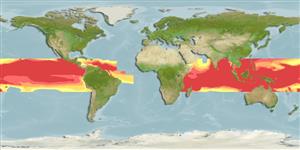Common names from other countries
Issue
Issue on validity of subspecies: subspecies considered as valid in FB, elevated to species rank as Oxyporhamphus micropterus (Valenciennes, 1847) in Eschmeyer (CofF ver. Mar. 2011: Ref. 86697). Please send references, or more studies are needed.
Environment: milieu / climate zone / depth range / distribution range
Écologie
marin; océanodrome (Ref. 51243); profondeur 0 - 1 m (Ref. 58302). Tropical; 20°N - 20°S
Indo-Pacific: East Africa to Tonga, north to southern Japan (Ref. 33390). Eastern Pacific: Mexico to Peru (Ref. 9306). Replaced in the Atlantic by Oxyporhamphus similis.
Length at first maturity / Taille / Poids / Âge
Maturity: Lm 12.8, range 13 - 13 cm
Max length : 18.5 cm SL mâle / non sexé; (Ref. 9843)
Épines dorsales (Total) : 0; Rayons mous dorsaux (Total) : 13 - 15; Épines anales: 0; Rayons mous anaux: 13 - 16; Vertèbres: 47 - 50. Adults with a single large chamber to the swim bladder. Average number of gill rakers on the first arch, 30.7; predorsal scales, 31.1 on the average. Branchiostegal rays: 11-14 (Ref. 36576).
A true oceanic species, not bound to coastal waters at any period of its life (Ref. 9843).This species is the only halfbeak which doesn't have an extended lower jaw at the adult phase (Ref. 9306). Oviparous, with planktonic eggs and larvae (Ref. 36576).
Collette, B.B., 1986. Hemiramphidae. p. 388-391. In M.M. Smith and P.C. Heemstra (eds.) Smiths' sea fishes. Springer-Verlag, Berlin. (Ref. 4164)
Statut dans la liste rouge de l'IUCN (Ref. 130435)
CITES (Ref. 128078)
Not Evaluated
Menace pour l'homme
Harmless
Utilisations par l'homme
Outils
Articles particuliers
Télécharger en XML
Sources Internet
Estimates based on models
Preferred temperature (Ref.
115969): 26.3 - 29.2, mean 27.9 (based on 25608 cells).
Phylogenetic diversity index (Ref.
82804): PD
50 = 0.7500 [Uniqueness, from 0.5 = low to 2.0 = high].
Bayesian length-weight: a=0.00324 (0.00148 - 0.00710), b=3.08 (2.90 - 3.26), in cm Total Length, based on LWR estimates for this (Sub)family-body shape (Ref.
93245).
Niveau trophique (Ref.
69278): 3.1 ±0.15 se; based on food items.
Résilience (Ref.
120179): Haut, temps minimum de doublement de population inférieur à 15 mois (K=1.0).
Fishing Vulnerability (Ref.
59153): Low vulnerability (15 of 100).
